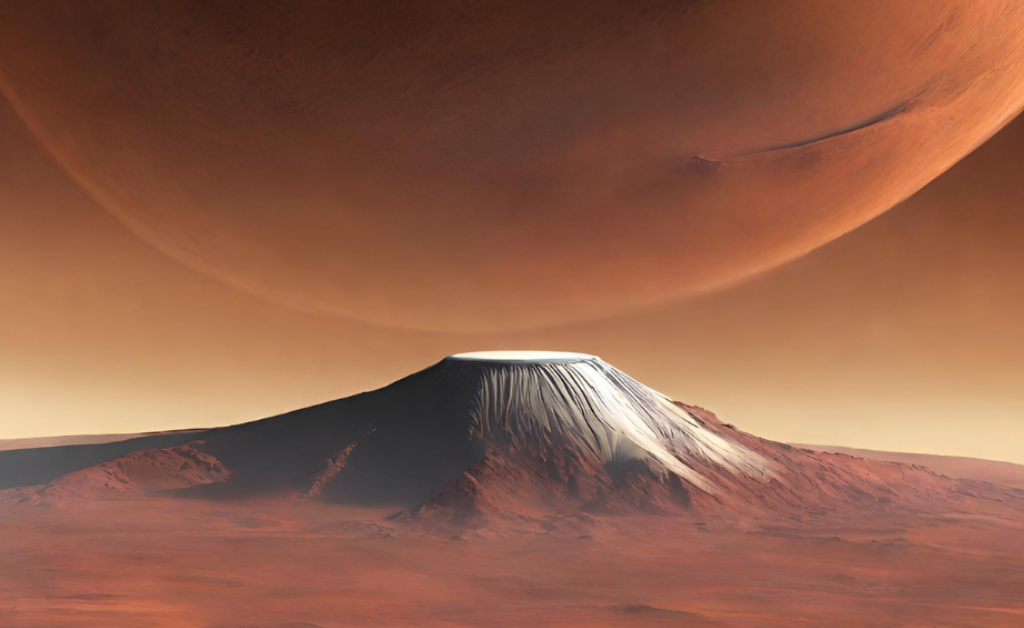Olympus Mons: The Largest Volcano Which is Three Times Taller Than Everest, and Twice as Wide

/ Olympus Mons is the largest volcano in the solar system, and one of the largest volcanoes in the known universe.
Date: 06 Oct 2023 15:45 PM IST
Introduction
Nestled on the rust-colored surface of the Red Planet, Mars, lies a geological marvel that has captured the attention of scientists and space enthusiasts worldwide – Olympus Mons. This colossal shield volcano stands as a testament to the fascinating geology of Mars. With its astonishing height of over 21.9 kilometers (13.6 miles), it reigns as the largest volcano in our entire solar system, dwarfing Earth’s tallest peak, Mount Everest, by a factor of three.
In this article, we will embark on a journey to uncover the secrets and significance of Olympus Mons, exploring its formation, characteristics, and the implications it holds for future Martian exploration, all while diving into the fundamental question: What are volcanoes?
Understanding Volcanoes
Volcanoes are natural geological features found on both Earth and other celestial bodies in our solar system. They are characterized by the expulsion of molten rock, ash, and gases from beneath the planet’s surface. These eruptions can be explosive, like the famous eruption of Mount Vesuvius in AD 79, which buried the Roman city of Pompeii, or they can be relatively calm, like the steady outflows of lava from shield volcanoes such as Olympus Mons.
Formation and Characteristics
Olympus Mons is a shield volcano, characterized by its broad, gently sloping profile, reminiscent of a warrior’s shield lying on the ground. Its immense size is attributed to millions of years of volcanic activity fueled by repeated eruptions of fluid lava.
The lava flows that formed Olympus Mons were exceptionally fluid, allowing them to spread out over a vast area and create the volcano’s expansive base. The base itself is an astonishing 624 kilometers (374 miles) across, covering an area of over 300,000 square kilometers (120,000 square miles).
Despite being currently dormant, Olympus Mons bears evidence of activity as recent as 25 million years ago. Located in a region of Mars believed to be volcanically active, the possibility of future eruptions adds an element of intrigue to this Martian giant.
Why Olympus Mons is So Large?
One of the key factors contributing to Olympus Mons’ colossal size is the unique geological dynamics of Mars. Unlike Earth, where tectonic plates shift and volcanoes shift with them, Mars lacks mobile tectonic plates. Instead, the Martian crust remains stationary over a hotspot. As a result, a volcano can continue to spew lava until it reaches staggering heights, unhampered by plate movement.
Furthermore, the gentle slopes that define Olympus Mons, with an average gradient of only 5%, are a direct result of the fluidity of the lava flows. These flows could spread extensively before cooling and solidifying, giving rise to the remarkable shield-shaped structure.
Significance of Olympus Mons
Olympus Mons holds immense scientific and symbolic significance:
Largest Volcano: It is the largest volcano not only on Mars but in the entire solar system, serving as a testament to the scale and diversity of geological features in our celestial neighborhood.
Geological Insights: The volcano provides valuable insights into the geological history and dynamics of Mars, offering clues about its past and the forces that have shaped it.
Planetary Exploration: Olympus Mons hints at the potential for future human exploration and colonization of Mars. Located in a region thought to be rich in water ice, the volcano could become a resource for generating geothermal energy and sustaining future missions.
Conclusion
Olympus Mons stands as a monumental geological masterpiece, reminding us of the astonishing wonders that the cosmos has to offer. Its immense size, unique formation, and the potential it holds for future exploration make it a symbol of our relentless quest to uncover the mysteries of our neighboring planets. As we continue to gaze at the heavens and dream of venturing beyond Earth, Olympus Mons will remain an enduring testament to the marvels of our solar system.
Reference: Wikipedia.
